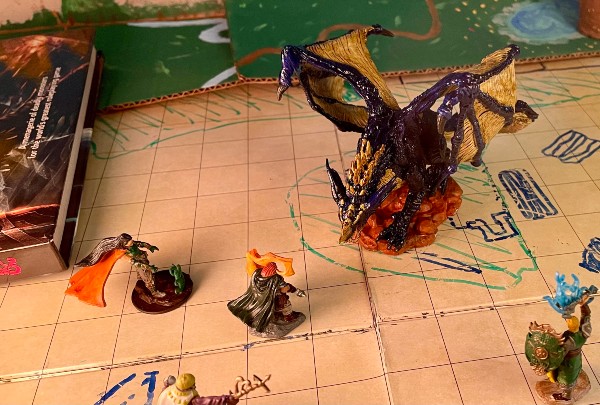The next time you hit a creature with a melee weapon attack during the spell’s duration, your weapon flares with white-hot intensity, and the attack deals an extra 1d6 fire damage to the target and causes the target to ignite in flames.
At the start of each of its turns until the spell ends, the target must make a Constitution saving throw. On a failed save, it takes 1d6 fire damage. On a successful save, the spell ends. If the target or a creature within 5 feet of it uses an action to put out the flames, or if some other effect douses the flames (such as the target being submerged in water), the spell ends.
At Higher Levels. At Higher Levels. When you cast this spell using a spell slot of 2nd level or higher, the initial extra damage dealt by the attack increases by 1d6 for each slot.
Casting Time: 1 bonus action
Range: Self
Components: V
Duration: Concentration, up to 1 minute
School: 1st-level evocation
Who can cast Searing Smite? Paladins and Rangers have Searing Smite on their class spell lists. Forge Clerics get Searing Smite for free and always have it prepared.
Player’s Handbook, pg. 274
Searing Smite 5e
Searing Smite adds a fiery blast to your next successful melee strike and sets the target aflame to boot. On its own, it’s fairly “meh,” but with a bit of optimization and some creative thinking, Searing Smite can be a really solid spell in DnD 5e.
How Does Searing Smite Work in 5e?
Searing Smite buffs the caster for up to 1 minute (concentration permitting), causing their next melee attack that lands to deal 1d6 additional fire damage (average of +3.5). Additionally, the target ignites in flames and must make Constitution saving throws at the start of each of its turns for the duration of the spell.
If the target fails this save, it takes 1d6 fire damage; if it passes, the spell ends. The target or a creature within 5 feet can use its action to douse the flames. Normal effects that douse flames (like water) will also end the spell.
Searing Smite can be upcast, but it only increases the initial fire damage by 1d6; it has no effect on the damage over time that the flames cause at the start of the target’s turns.
How to Use Searing Smite 5e?
Searing Smite may seem like a straightforward damage boost with a twist of damage over time, but there are some ways to get the most out of this spell.
-
Stack with Divine Smite and Booming Blade. So Paladins will need the Magic Initiate feat to get Booming Blade, but pairing this spell with Divine Smite and Searing Smite can get you some incredible single-round results. Take advantage of that bonus action cast time on smite spells to use a cantrip like Booming Blade or Green-flame Blade.
-
Mess with enemy’s actions. The best part about igniting a target with Searing Smite isn’t actually the fire damage itself — it’s the action that gets wasted to put out the flames (as most creatures will instinctively do).
This makes Searing Smite a lot more powerful than you might think, even at higher levels, so long as the enemy actually fails their Constitution saving throw and your DM chooses to douse the flames.
-
Start fires. While there are cantrips out there that can start fires (Fire Bolt, Create Bonfire), you might not have those in your party. In a pinch, a Paladin or Ranger with Searing Smite can get some flames going.
-
Be wary of targets with high Constitution modifiers. Constitution ties Strength for the highest monster stat in the game at 15. (credit to Reddit user RufflesDMAccount for their spreadsheet!)
But if you’re not afraid to get a bit meta-gamey, you can take a peek behind the curtain at common foes in your universe, and try to target those that have lower Constitution modifiers, as they’re more likely to catch on fire and stay on fire.
What Are the Rules for Searing Smite in 5e?
The rules for Searing Smite in DnD 5e are as follows:
-
You can attack after casting Searing Smite. Searing Smite’s casting time is a bonus action, so you can still take a normal action after casting it (except for casting another leveled spell) (PHB 202).
-
Searing Smite only affects the caster’s next melee attack that lands. The “up to 1 minute” part means that the spell will stay on your weapon for up to 1 minute and that the target can burn for up to 1 minute. It does not mean that every attack you make for 1 minute gets +1d6 fire damage and causes flames to ignite.
-
Searing Smite only affects the target when a melee attack actually hits it. If you miss your attack roll, Searing Smite stays active for as long as the spell’s duration lasts and your concentration stays on the spell.
Do note, however, that the spell’s 1-minute duration applies to both when it’s on your weapon and when it’s causing persistent fire damage, so the sooner you actually land an attack, the more damage potential you get out of the spell.
-
Searing Smite can affect attacks of opportunity. Since Searing Smite only specifies “the next time you hit a creature with a melee weapon attack,” and since opportunity attacks are melee weapon attacks, the spell’s damage/effect can be applied on an attack of opportunity. Here’s Sage Advice confirmation.
"The next time you hit a creature with a weapon attack before this spell ends…"
If the next time you hit a creature with a weapon attack before the spell ends is on an opportunity attack, they get smote.
— Dan Dillon (@Dan_Dillon_1) January 22, 2020
-
Searing Smite can ignite objects. You can make melee attacks against objects as well as creatures. If you do, Searing Smite’s damage and flame-igniting effect will both apply to the object.
-
Paladin’s Divine Smite can stack with Searing Smite (and other smite spells). Divine Smite is a second-level Paladin feature that deals bonus radiant damage upon hitting an enemy.
Even though the feature and certain spells both have the word “smite” in them, there’s nothing preventing players from stacking the two effects. Here’s confirmation from Sage Advice.
A paladin can use Divine Smite on the same weapon attack that benefits from a smite spell like wrathful smite. #DnD https://t.co/0m11gBoKLp
— Jeremy Crawford (@JeremyECrawford) March 15, 2016
-
You cannot wait to see whether an attack lands before deciding whether or not to cast Searing Smite. While Divine Smite allows you to wait until you actually land your attack to decide whether you want to use it, Searing Smite (and other smite spells) requires you to cast the spell before attacking.
Even with a bonus action, you have to resolve your attack action first (unless a feature specifies otherwise).
-
You must use a melee weapon with Searing Smite. Sorry, no fiery archer fun for you.
Is Searing Smite 5e a Good Spell?
Yes, Searing Smite is a good spell for Paladins — for Rangers, it’s a little “meh.” For either class, spell slots are extremely precious and few, so it is sometimes hard to justify using it. However, when you can effectively force an especially troublesome enemy to waste their whole turn dousing the flames, it helps the whole party.
Searing Smite 5e DM Tips
As a DM, I only have one tip: put the flames out with whoever your players target with Searing Smite in most scenarios. Even though 1d6 damage is negligible, you should ignore the numbers and ask yourself one question: would the creature I’m controlling immediately put the flames out, or carry on fighting as though nothing was amiss?
Of course, some badass monsters might truly not care about being a little bit on fire — use your roleplaying judgment rather than your meta-gamer judgment is all I’m saying.
DnD 5e Searing Smite FAQ
Searing Smite DnD 5e FAQ:
-
Can you use Searing Smite with unarmed strikes? No, Searing Smite cannot be used with unarmed strikes. Unarmed strikes do not count as weapons, and Paladin’s smite spells (and Divine Smite) require a weapon to be used (PHB 195, Sage Advice Compendium).
-
Is Searing Smite a one-time use? Yes, Searing Smite is a one-time use spell. It lasts for one successful attack (it remains ‘on’ if attacks miss), and the smiting effect is applied only once. However, it does have a persistent effect, dealing additional fire damage on subsequent turns if the target fails subsequent saving throw throws.
-
Can you use Searing Smite and Divine Smite together? Yes, you can use Searing Smite and Divine Smite together. Divine Smite doesn’t interfere with spellcasting, and therefore doesn’t prevent the use of smite spells, including Searing Smite. Note that Searing Smite must be cast before attacking, whereas Divine Smite is used after an attack lands.
Simple Searing Smite 5e Spell Text
Searing Smite: (1st-level evocation, self, concentration, up to 1 minute, V) The next time you hit a creature with a melee weapon attack during the spell’s duration, the attack deals an extra 1d6 fire damage.
At the start of its turns until the spell ends, the target makes a Constitution saving throw. On a failed save, it takes 1d6 fire damage. On a successful save, the spell ends. If the target or a creature within 5 feet of it uses an action to put out the flames, or if some other effect douses the flames, the spell ends.
+1d6 initial fire damage per slot level above first.


![Thunderous Smite 5e [DnD Spell Guide: Uses, Rules, Tips] dungeons-and-dragons-beholder-vs-party](https://www.dndlounge.com/wp-content/uploads/2022/03/dungeons-and-dragons-beholder-vs-party-300x225.jpg)
![Shape Water 5e [DnD Spell Guide: Uses, Rules, Tips] dnd-5e-character-sheet-and-die](https://www.dndlounge.com/wp-content/uploads/2022/03/dnd-5e-character-sheet-and-die-300x157.jpg)
![Shillelagh 5e [DnD Spell Guide: Uses, Rules, Tips] owlbear-dnd-5e](https://www.dndlounge.com/wp-content/uploads/2022/03/owlbear-dnd-5e-300x218.jpg)
![Flaming Sphere 5e [DnD Spell Guide: Uses, Rules, Tips] find-familiar-5e](https://www.dndlounge.com/wp-content/uploads/2022/03/find-familiar-5e-300x159.jpg)